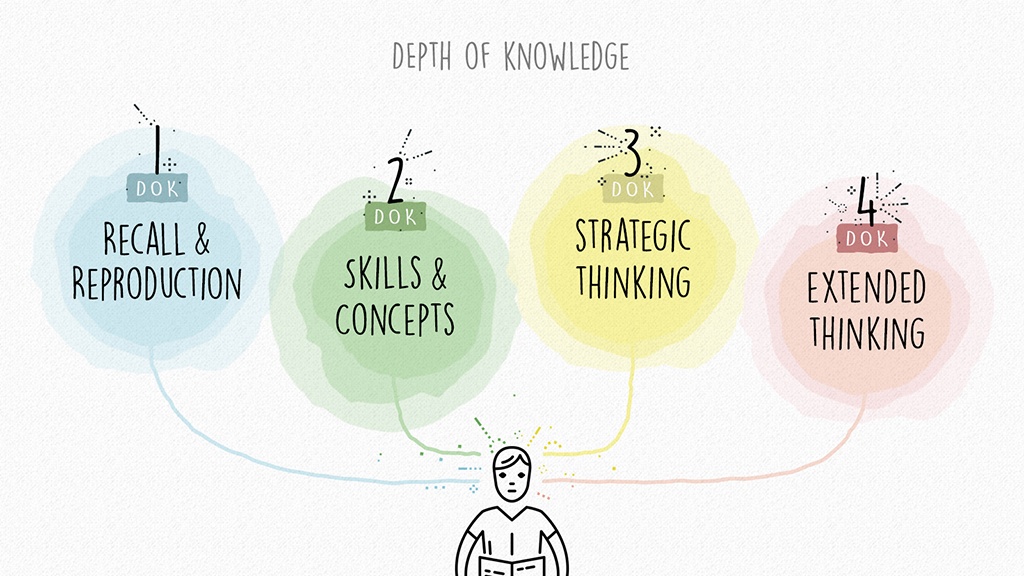
How do educators create the ideal mix of content coverage while at the same time training students to think and analyze novel situations?
Just keeping up with local, state, and national standards leaves the average teacher overwhelmed and wondering how they will ever cover all the content that their students might be tested on. But worrying about content coverage should be secondary to teaching students skills and concepts that they can apply in novel situations (e.g., life outside of school). One strategy for solving this is to make sure that we are teaching students complex thinking while we cover essential content.
Subscribe to the blog to get the next post emailed to your inbox.
What is Depth of Knowledge?
In the world of standardized testing, thinking complexity is commonly referred to as depth of knowledge (DOK). Questions for students to answer or tasks for them to complete can be categorized on a four-point scale, with each point representing a higher level of thinking complexity. Don’t confuse complexity with difficulty. Difficulty can be defined as statistical fact-based on a certain sample, very few of students get the correct answer. The key distinction is that a complex question requires higher-order thinking skills—for example, thinking through an answer that involves multiple steps. The more steps a student must complete to provide an answer, the greater depth of knowledge required.
The four levels in the Depth of Knowledge schema
Level I: Recall/Reproduction
Recall a fact, information, or procedure. Identify information in a text, image, or chart. Answers to these types of questions are either correct or incorrect. Examples might be:
- Who was the first president of the United States?
- What was the name of the king who was killed at the beginning of the French Revolution?
Level II: Skill/Concept
Use information or conceptual knowledge. Questions may involve inferring or assessing cause and effect. This requires students to work with skills and concepts in order to respond to a question. These questions usually have correct or incorrect answers but require students to engage in multiple steps to formulate their response. For example:
- Compare and contrast how the balance of power between states and the federal government changed during the terms of the first three presidents.
- How was the French Revolution similar to the American Revolution?
Level III: Strategic Thinking
Requires reasoning, developing a plan, or working through a sequence of steps. Encourages students to build upon factual and conceptual knowledge in order to assert their own position on an issue—to evaluate, synthesize, or reason through a response. For example:
- Compare these two authors in their assessment of the importance of the American presidency and explain which one you agree with. Use examples to support your answer.
- Based on information from these three authors, what would you argue were the most important aspects of the French Revolution?
Level IV: Extended Thinking
Involves investigation, using multiple sources, as well as time to think about and process multiple conditions of the problem. Level IV is not about getting the “right” answer so much as arguing for and supporting a conclusion or hypothesis with evidence. It requires students to extend their thinking. This may include doing extended research, summarizing, and then asserting their own conclusions. This type of thinking usually requires more time for students to process information, so you rarely find this level of analysis in “on-demand” assessments. Examples might be:
- Assess the strategies that Washington used in the War of Independence. Which were the most effective in your opinion? Cite examples to support your conclusion.
- How was the French Revolution similar to or different from the revolutions of 1848 in Europe? As part of your answer, be sure to define “revolution” and use evidence from a variety of sources to support your conclusions.

Contrasting DOK with Bloom’s Taxonomy
People familiar with Bloom’s Taxonomy often focus on the similarity to DOK levels, but it is important to note that there are important differences. While Bloom taught us to focus on the verbs we use (e.g. recall, explain, analyze), DOK levels are based on the context of the question—what comes after the verb. Note the following three examples use the same verb, but represent increasing levels of complexity:
- Describe the characteristics of a democratic political system.
- Describe the differences between a democratic political system and an authoritarian one.
- Describe a chart that allows one to compare the similarities and differences of multiple political systems.
The verb is the same, but the tasks require deeper and more complex thinking (steps and conceptual reasoning) as we progress.
Content coverage AND rigorous thinking
To ensure that your assessments represent not only content coverage but also help your students think rigorously and in complex ways, be sure to ask questions that invoke all levels of DOK sophistication. This will not only better prepare students for standardized testing but also for life.
Resources:
- Burn This! Why the D.O.K. Wheel Does NOT Address Depth of Knowledge
- Webb’s Depth of Knowledge Guide
- Developing Higher-Order Thinking Questions Based on Webb’s DOK and FCAT Content Complexity
- DOK Question Stems – Ohio Department of Education
- Depth of Knowledge (DOK) Overview Chart
Sign up for a free trial of Active Classroom and access hundreds of activities and assessments to measure depth of knowledge
Dr. Aaron Willis is the Chief Learning Officer for Social Studies School Service. He works with districts around the country to provide resources, strategies, and training to help teachers make meaningful connections with their students. He can be reached via email at [email protected]. Follow him on Twitter @Dr_Aaron_Willis.

